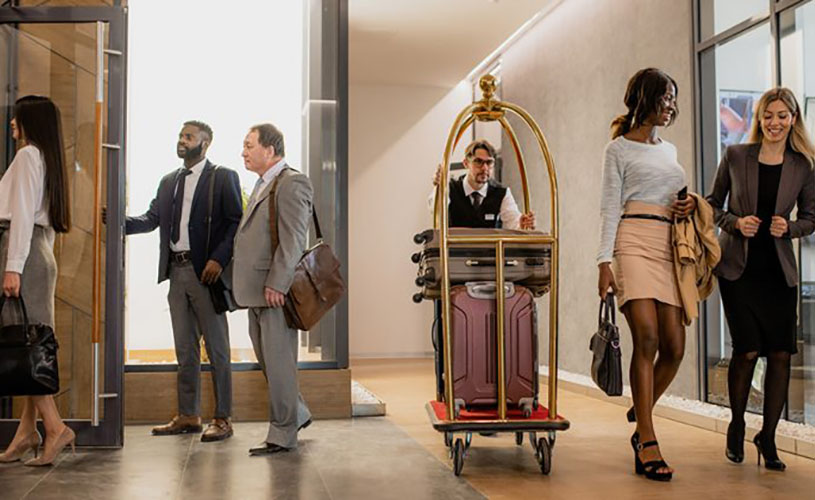
By David Millili
Hospitality and travel industry momentum remains strong as people are unwilling to give up travel and experiences again
Despite fears of a probable global recession and the impact of rising interest rates and inflation looming, travel demand is seeing no sign of slowing down. While other industries may see a slowdown, people are reluctant to give up travel and experiences again.
The most recent American Travel Sentiment Study indicates that 92% of Americans have travel plans in the next six months, which is among the highest level of travel seen since the beginning of the pandemic. Airports have once again transformed into thriving hubs of activity and organized chaos. Hotels are booked, flights are full, and travelers worldwide are excitedly hashing out long-awaited travel plans that were written off for two years as an unfortunate casualty of the COVID-19 pandemic. As a hospitality professional, you can’t help but sit back and observe the momentum with a cocktail of emotions – a healthy serving of gratitude and optimism with a dash of incredulous relief.
Of course, we knew this recovery period would arrive eventually. Still, after the unprecedented hardship that crashed over our industry while the world came to a standstill, it’s almost hard to believe that our comeback is officially underway. The best part? The hospitality industry isn’t just recovering – it appears to be entirely revived and eager to satiate the appetite for travel that is once again reflected around the world. If 2021 was a lost year for the travel and hospitality sector, and 2022 represented our redemption arc, could 2023 usher in even more growth? If you ask me, all signs point to yes.
The Travel Boom: Worth the Wait
In an article published to Stay Magazine this summer, research conducted by Cushman & Wakefield’s INNSIGHT Quarterly report on the Canadian Hospitality sector helped to illustrate the upwards trajectory of the industry. “2022 will be the pivotal year of the recovery,” the article read. “Q2 2022 has seen a strong recovery in the hotel sector. While occupancy continues to improve nearer 2019 levels, the strength of ADR growth has surprised many — particularly during periods of relatively concentrated demand. Hotel performance across Canada reached 100% index in mid-June, and for the weeks ending June 18th through July 9th, RevPAR actually surpassed 2019 levels.” Moreover, the American Hotel & Lodging Association (AHLA)’s 2022 Midyear State of the Hotel Industry Report revealed that hotel room revenue is projected to surpass $188 billion by the end of 2022, eclipsing 2019 figures on a nominal basis.
If that hasn’t convinced you, let’s look to Airbnb, the ever-popular rival to traditional hospitality, which slowly but surely took Silicon Valley (and the world at large) by storm over the last decade. During a recent podcast episode, Skift offered up a deep dive into Airbnb’s record-breaking quarter, noting that Airbnb’s net income rose 46% year-over-year to $1.2 billion, its highest-ever quarter, for the period that ended September 30. The company also generated third-quarter revenue of $2.9 billion and had 90 million guest arrivals (another record breaking achievement). Finally, Airbnb generated 99.7 million “nights and experiences” booked, which indicates 25% year-over-year growth.
In fact, Airbnb wasn’t the only hospitality company to catch Skift’s attention recently. In October, the publication highlighted the growth experienced by the rental car giant Hertz, which reported a 12% jump in quarterly revenue to $2.5 billion (compared to $2.23 billion a year ago). The cause for this jump, it appears, is the increased demand for rental cars as the leisure travel industry once again finds its stride.
In a recent interview, Hertz Chief Executive Stephen Scherr explained that Hertz was enjoying the same strong conditions for travel reported by airlines, hotels, and others, seeing undeniable strength in demand across leisure, corporate, and for us, our ride-share business. According to Sherr, there were “elevated bookings” for international inbound travelers for upcoming trips even despite economic pressure and inflation, with bookings around the Christmas holidays for places like California and Florida reflecting demand that is effectively double 2021 levels.
Looking Beyond Leisure
The pent-up demand for travel which is currently shifting the hospitality industry into high gear, can’t be attributed exclusively to leisure travel. Other integral industry segments are also making a notable comeback, including meetings and events. Referencing research released by Knowland, a hospitality data and technology company, Skift has reported that the meetings and events industry is on track to reach full market recovery next year. The forecast revealed a 72.1% recovery by the end of 2022 for the U.S. meetings industry, which represents a significant upgrade from the 58.3% forecasted in April. Even better, meeting levels are expected to reach 106.3% of 2019 levels in 2023 and 115.7% in 2024.
Much of this growth may be attributed to the heightened demand for corporate events, with several markets reportedly recovering at more than 90% of 2019 levels in this segment. Hertz has reiterated this finding, noting that the length of corporate car rentals has increased on average by a little more than one day as an influx of business travelers look to combine business and leisure while traveling. The Global Business Travel Association also predicts corporate travel spend will once again reach $1.4 trillion in 2026, compared to the $661 billion spent on business travel in 2020 amidst pandemic travel restrictions.
The resurgence of travel demand, coupled with staffing challenges cited across the industry, has primed hotels to abandon legacy tech in favor of modern offerings. Now, more than ever, hospitality brands seek next-generation platforms and processes to empower their teams to do more with less while upholding stringent guest service standards. As guest preferences continue to shift to favor hospitality brands that prioritize convenience, personalization, and sustainability, intuitive technology will become even more omnipresent across the industry.
The (Near) Future of Hospitality
These observations are especially reassuring when we compare them with trends revealed across other industries as inflation wreaks havoc on consumer spending and economic pressure mounts. In September, Bloomberg reported a significant decline in retail sales, noting that seven of 13 retail categories declined, including auto dealers, furniture outlets, sporting goods stores, and electronics merchants. “As inflation shows few signs of slowing, many Americans are still relying on credit cards and savings to keep up, and shelling out more on essentials leaves little leftover for discretionary purchases,” reads the report.
While a stagnant retail climate warrants concern for most industries, travel and hospitality might be somewhat sheltered from economic downturns. After all, with two years of travel lost, people are seemingly more willing than ever before to save for leisure trips, work abroad from international locations, or add additional days to their business trip to once again embrace the joys of domestic and international experiences.
As the saying goes, “you don’t know what you have until it’s gone, and now, more than ever, global travelers know what it’s like to have travel taken away from them. After that prolonged period of isolation, many consumers are simply no longer willing to relinquish the ability to travel, even during a period of economic uncertainty.
This period of momentum is one to celebrate and also a strong indication of what’s to come in 2023. Perhaps more importantly, it serves as a reminder for hospitality brands to invest in the tools and processes that will ensure their hotels are ready to meet increased demand and delight guests.


